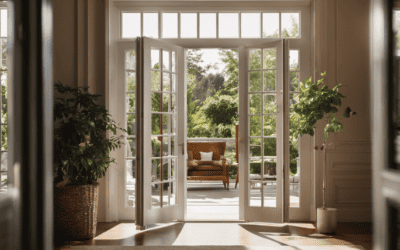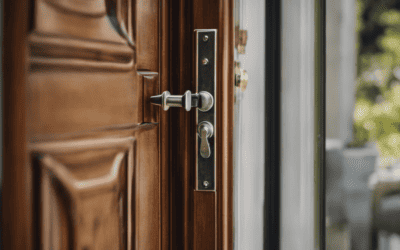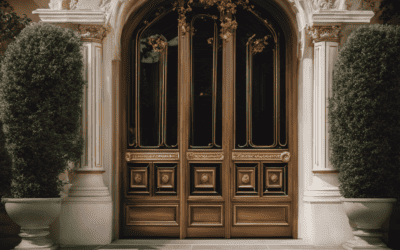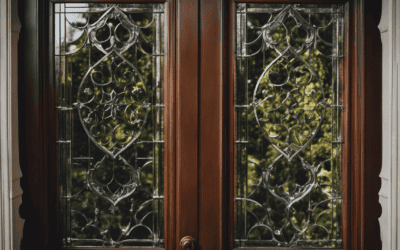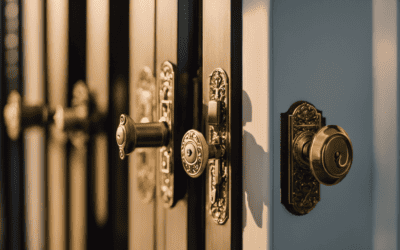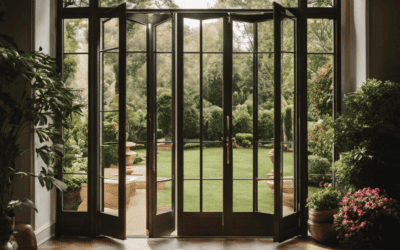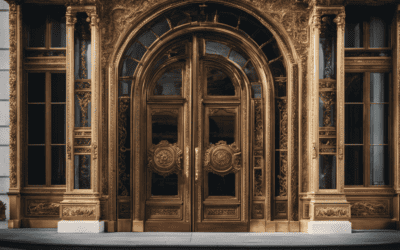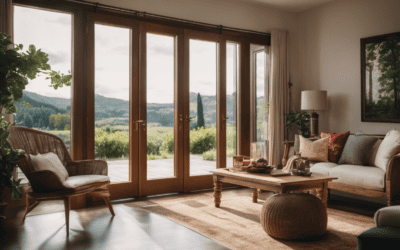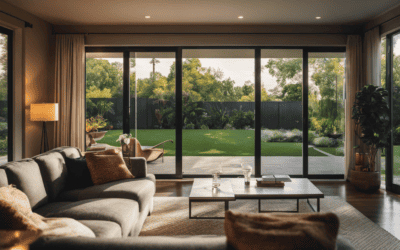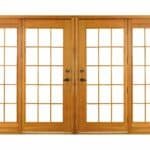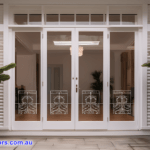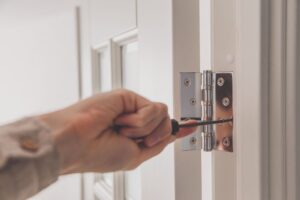 It typically takes between 4-7 hours to properly install exterior French Doors, depending on the complexity of the project and any potential issues that may arise during installation. With a comprehensive understanding of all aspects related to installing this door style, you can efficiently prepare for your project to reduce time spent on site. It is important to have a clearly planned installation process before beginning, considering building codes and regulations as well as climate and weather conditions.
It typically takes between 4-7 hours to properly install exterior French Doors, depending on the complexity of the project and any potential issues that may arise during installation. With a comprehensive understanding of all aspects related to installing this door style, you can efficiently prepare for your project to reduce time spent on site. It is important to have a clearly planned installation process before beginning, considering building codes and regulations as well as climate and weather conditions.
The process itself involves measuring accurately (including height and width), prepping an opening if needed, ensuring levelness or plumpness with shims where necessary, and attaching hinges correctly using proper installation tools.
Other important steps include selecting quality materials appropriate for each application, such as framing lumber type & grade, hardware (door handle, hinges, weather stripping) that will withstand weathering over time, and completing finishing touches like trim and sealing.
Careful consideration must be given to all of these factors to ensure that the installation process is carried out in an experienced and proficient manner.
How To Install Exterior French Doors In Existing Opening
Installing an exterior French door in an existing opening is a relatively simple task that can be completed with the right tools and materials. Here are some basic instructions to follow when installing a new exterior French door:
- Measure your door frame: Before ordering any materials, measure the inside of your current door frame (width and height) to determine what size exterior French door will fit best. Making sure you have accurate measurements before proceeding with installation is essential for success!
- Preparing Your Door Frame & Site: The site must be prepared by removing all previous hardware from the doorway. Cover flooring near entranceways as necessary and ensure there’s access on both sides of the entryway if applicable. Brace adjacent areas during the construction phase. Prepare framing area by nailing 2×4 lumber around the perimeter between studs, ensuring each piece slightly overlaps the next one to create a stable base structure, which serves as a platform for mounting jamb components onto it. Once prepped, remove excess debris and vacuum or sweep away remaining particles/dust accordingly. Then proceed to fasten the sill component into place first.
- Secure Sill Component & Install Jambs / Trim Moldings: Using screws, secure the frames together using top mullions, securing them securely across the entire width at least 1 inch below the head casing (use a tape measure to ensure correct placement). Then install the jambs and trim mouldings accordingly.
- Hang/Attach French Door: Place the exterior French door onto the jamb, and adjust the hinges as necessary with a drill or screwdriver until secure and properly aligned with the latch strike plate. Make sure all fasteners are tightened up. Insert any required weather stripping components between the frames and verify that everything is sealed tightly before finishing the installation process!
How To Install Exterior French Doors On Concrete
 Installing exterior French doors on concrete can seem challenging, but with the right tools and know-how, you can do it yourself quite easily. Here is an easy-to-follow guide on how to install exterior French doors on concrete:
Installing exterior French doors on concrete can seem challenging, but with the right tools and know-how, you can do it yourself quite easily. Here is an easy-to-follow guide on how to install exterior French doors on concrete:
- Start by getting the area ready for installation. Check for any obstructions, such as pipes or wires in the wall. You will also need to mark out the area of your doorframe.
- Use a hammer drill and masonry bit to cut through the concrete to make room for the frame. Cut slightly deeper than you need, then fill any extra space with mortar. Once dry, smooth down to match the surface of the existing concrete wall.
- Attach your doorframe using lag screws and washers flat against the concrete wall. Ensure all screws are tightened securely to hold properly onto the mounting surface.
- Begin installing small sections of your door at a time, starting with the hinges and then moving on to lockset mechanisms and other components. Ensure all joints are sealed properly with an adhesive caulk or foam sealant before continuing with the installation process.
- Finish off by attaching weatherstripping along the edges of a doorway, the bottom sill guard, and top fascia boards (depending on the type). Measure these items twice before cutting them down to size to fit snugly up against the jamb moulding that you have already attached to the concrete wall surface.
- Lastly, install a threshold strip along the base of the frame to provide additional protection from outside elements such as water, snow or even vermin from entering the house’s interior living space!
How To Install French Doors In An Exterior Brick Wall
Installing French doors in an exterior brick wall is a great way to increase your home’s curb appeal and add more light. Doing it yourself can save money, but a few steps should be followed carefully to ensure a professional-looking finished product.
• Define the opening in the brick where you plan to install the door.
• Use circular saws with masonry blades to cut out the desired shape.
• Make sure any electrical lines, water pipes, or gas pipes lying behind the wall are properly shielded by insulation before installation.
• Use ladders or scaffolding around openings if required for safety while working at high heights.
• Secure door mechanisms parts such as hinges and jamb brackets according to manufacturer instructions
• Grout masonry blocks and secure them with screws.
• Insulate around the opening area with spray foam insulation where necessary.
• Install weather-sealing materials around openings for air leak prevention.
• Attach the frame of French doors to holes drilled into brick walls with steel bolts and anchors.
• Apply caulk or grout along the base and top of the frame, then cover with trim pieces for aesthetics.
Following these steps carefully will help anyone successfully install French doors in an exterior brick wall on their own – saving time and money and giving their home a beautiful new look!
How To Install French Doors Without Frame
Installing French Doors without a Frame is a DIY project that can make all the difference in how you enjoy your home. Here’s what you need to get started:
• Drill and Bits
• Tape Measure
• Level
• Chisel
• Carpenter’s Hammer
• Jigsaw
• Router
• Shims
• Hinges and Hardware for Door Installation
 Follow these steps to install your French doors without a frame:
Follow these steps to install your French doors without a frame:
• Cut the opening. Take measurements of the existing opening to determine how much drywall or brick has to be cut away. Mark your measurements with a pencil and use a jigsaw to make the cuts.
• Check levels. Use a level and shims to check whether everything matches up. If needed, add more shims where necessary.
• Build the header support beam if none exists. Measure and mark the area where you will build the header support beam, which will act as a top frame for your door. Cut two 2×6 boards into one 13-foot longboard, then mark four 18-inch sections on it––these will form your header support beam once you’ve drilled pilot holes in them, removed any sawdust from drilling, added wood glue to hold them together, and secured them with nuts and bolts. Secure this piece to wall studs using screws or nails for extra stability.
• Create openings between jambs for hinges; this makes sure that they fit snugly within their frames when closed. Chisel out hinge space slowly until it fits the hinge properly; check size regularly, as going too deep can affect how the door sits on the hinge when closed.
• Install door knob and lock in place before placing door onto hinges; predrill holes into the finished surface of the door before adding screws, so they don’t break through as you tighten each screw in place
• Position hinges onto existing jambs after making sure they are level with each other; predrill screws into holes already made in step 5; screws should fit snugly but not overly tight—if too tight, it will cause strain on jambs when opened/closed
• Hang the door by positioning the first hinge overexposed edge of the cutout jamb, lining up holes of both parts before hammering firmly together ––position the second hinge over the opposite jamb hole and continue the process until finished
• Ensure that all screws have been tightened so no part of the structure becomes loose while being used; recheck levels after installation if there was a deviation earlier during the install
Once finished installing French doors—without frames—check levels again one last time before enjoying the newly improved entryway!
Can You Install French Doors Yourself
Installing French doors yourself is a simple procedure and can be completed relatively quickly with the right tools, materials and instructions.
However, it is important to understand the application to ensure that the door is properly installed and secure.
Materials Needed:
To install a French door yourself, you will need certain items, including a level, drill, shims, hammer and a handsaw. It’s also advantageous to pick up an extra set of door hinges, as these are necessary for installation but are not always included with pre-hung doors.
Instructions:
To begin installing your new French door, begin by following these steps:
1) Measure the area with the level’s help to ensure that the doorway is plumb or straight. It helps to mark any adjacent walls so that you know where your door should go once it’s ready for installation.
2) Place any necessary shims within the rough opening to compensate for any irregularities in floor height or an uneven space between your existing door frame and ceiling joists.
3) Once you have established that shimming has been done correctly, use a drill bit to pseudo-drill (make an indentation rather than cut all the way through) through your marked locations on either side of your doorway along both sides of your frame; these marks should correspond with studs located in both interior wall cavities.
4) Now take out the corresponding screws from both sides of your old door frame – this may require drilling them out if they are stuck in place – before setting aside any old shims or additional framing particles from around outside edges sealing gaps of the old frame section.
Tips/Things To Remember:
• During drilling, keep an even pace when removing screws and sawing excess framing material off- being too hasty can lead to mistakes that can be costly later on down the road since many pieces fit together like delicate puzzles.
• Make sure any excess framing material doesn’t interfere with alignment, and secure anchors from old frames are securely removed before fitting new ones in place. Especially pay attention to lower corners. Those typically fastened w nails or staples often bring surprises during removal. Double check precisely measure dimensions gap right angles oblong when dealing w carpentry measurement accuracy hugely important to job efficiency.
• Keep trim pieces and spares handy just case replacement is needed down the track. Never forget common practice, including hanging french doors overhang slightly slightly smaller than pocket hole dimension prevents bowing causes paint peeling etc.
How Much Does It Cost To Install French Doors
The cost of installing exterior French doors will depend on the size and complexity of the project. Professional door installers typically charge between $70 to $120 per hour for a two to five-hour installation job. The total cost for a set of French doors can range from $2,000 to $5,000, with the average labour cost being around $409 for a four-hour-long project. To hire a pro, you may pay anywhere from $140 up to 600 dollars on average. Generally speaking, single sliding type door installations that only open one section have an average price seen between 800-2000 dollars each.
To conclude, the time it takes to install exterior French doors can vary depending on various factors such as material selection, design complexity and energy efficiency. On average, installation should take approximately one day, with additional preparation work required beforehand. With knowledge of these intricacies along with professional terminology and facts, you will be able to provide expert advice for your customers’ installations to go smoothly from start to finish – ensuring that their needs are met both aesthetically and technically speaking.
References:
https://www.quora.com/How-long-does-it-take-to-install-a-door
https://www.youtube.com/watch?v=Gbxm6-s3UUk
https://www.bunnings.com.au/diy-advice/home-improvement/doors-windows/how-to-install-french-doors
Related Articles:
How to Build Steps Outside French Doors
We've all dreamed of stepping onto a grand patio framed by elegant French doors. But how do we bring that dream to life? Building steps outside French doors takes careful planning and attention to detail. We'll guide you through the process, from determining the...
An Insider’s Guide to Inswing French Doors
As an avid admirer of architecture, I'm thrilled to share my insider's guide to inswing French doors. These elegant entrances are a perfect blend of style and functionality. This article will explore the benefits of inswing French doors, considerations to remember,...
How to Keep a French Door Closed
Are you tired of struggling to keep your French doors closed and secure? Well, fear not! We've covered you with some practical tips and tricks to help you keep those doors shut tight. From installing high-quality deadbolts and hardware designed specifically for French...
Who Makes the Best French Doors
We've got you covered when it comes to finding the best French doors for your home. We know that homeowners like you want doors that not only enhance the beauty of your space but also let in plenty of natural light. That's why working with a skilled contractor with...
The Ins and Outs of French Door Construction: Are They Double Pane
Did you know that French doors are a popular choice among homeowners? They not only add elegance to a space, but they also provide timeless design. One important consideration regarding French door construction is whether they are double pane. Double-pane glass offers...
Different Types of French Door Locks
Are you looking to enhance the security of your French doors while maintaining the elegance they bring to your home? Look no further! In this article, we'll guide you through the different types of locks available for French doors. From surface-mounted locks that are...
How Far Do French Doors Open
Have you ever wondered how far French doors can swing open? Well, let us shed some light on this fascinating topic. When fully open, standard French doors can reach a width of about 5 feet. However, the range of motion can vary depending on various factors. Outswing...
What Is the Proper Name for French Doors
As we explore the proper name for French doors, let us open the doors of knowledge and shed light on this timeless architectural feature. With their charming glass panes and undeniable elegance, French doors have graced homes for centuries. They have become synonymous...
Should French Doors Open Inwards or Outwards
We all want our homes to reflect our style and provide a sense of belonging. And when it comes to French doors, deciding whether they should open inwards or outwards is important. Did you know that choosing the right direction can impact the functionality and security...
What Is Safer Sliding Glass Door or French Doors
When choosing between sliding glass doors and French doors, we all want to feel safe and secure in our homes. So, which option is safer? Let's dive into the details and explore the facts. Sliding glass doors may offer convenience, but hinged French doors have more...


